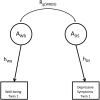Unraveling the Genetic and Environmental Relationship Between Well-Being and Depressive Symptoms Throughout the Lifespan
- PMID: 29962975
- PMCID: PMC6010548
- DOI: 10.3389/fpsyt.2018.00261
Unraveling the Genetic and Environmental Relationship Between Well-Being and Depressive Symptoms Throughout the Lifespan
Abstract
Whether well-being and depressive symptoms can be considered as two sides of the same coin is widely debated. The aim of this study was to gain insight into the etiology of the association between well-being and depressive symptoms across the lifespan. In a large twin-design, including data from 43,427 twins between age 7 and 99, we estimated the association between well-being and depressive symptoms throughout the lifespan and assessed genetic and environmental contributions to the observed overlap. For both well-being (range 31-47%) and depressive symptoms (range 49-61%), genetic factors explained a substantial part of the phenotypic variance across the lifespan. Phenotypic correlations between well-being and depressive symptoms across ages ranged from -0.34 in childhood to -0.49 in adulthood. In children, genetic effects explained 49% of the phenotypic correlation while in adolescents and young adults, genetic effects explained 60-77% of the phenotypic correlations. Moderate to high genetic correlations (ranging from -0.59 to -0.66) were observed in adolescence and adulthood, while in childhood environmental correlations were substantial but genetic correlations small. Our results suggest that in childhood genetic and environmental effects are about equally important in explaining the relationship between well-being and depressive symptoms. From adolescence onwards, the role of genetic effects increases compared to environmental effects. These results provided more insights into the etiological underpinnings of well-being and depressive symptoms, possibly allowing to articulate better strategies for health promotion and resource allocation in the future.
Keywords: adolescence; adulthood; childhood; depressive symptoms; heritability; well-being.
Figures



References
-
- Helliwell J, Layard R, Sachs J. World Happiness Report 2016, Update (Vol. I). (2017) New York, NY: Sustainable Development Solutions Network; (2016).
-
- Layard R. Happiness and public policy: a challenge to the profession. Econ J. (2006) 116:24–33. 10.1111/j.1468-0297.2006.01073.x - DOI
Grants and funding
LinkOut - more resources
Full Text Sources
Other Literature Sources

